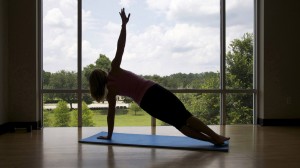 Brawn and muscle meet serene and controlled in the upstairs Mind & Body Studio of a crowded fitness center.
Brawn and muscle meet serene and controlled in the upstairs Mind & Body Studio of a crowded fitness center.
Grunts and clanging iron are swallowed by the heavy doors and New Age notes to reveal silent gasps and pants of their own: Gainesville Health & Fitness Pilates clients challenge their bodies in more ways than what traditional strength training can offer.
The popularity of Pilates has skyrocketed in recent years, blossoming into a $7 billion industry that’s on the rise — consumer research firm IBIS World expects revenues to reach $8.3 billion by 2016. More than 9.5 million men and women participate annually.
The increasingly sedentary state of society is making Pilates an essential training component for many, and the stress-management elements are helping more and more cope with the chaos of everyday life.
“The more we sit at a computer, text on our phones and drive long distances, the more we notice that things start to hurt,” said GHF Trainer Robin Zukowski, who has taught Pilates for more than 10 years. “Pilates is another element of wellness. Both men and women alike are learning they need to take care of their bodies and strengthen in a different way.”
Since the trend shows no sign of slowing, clubs not already featuring Pilates are wise to tap into the market. Here are some things to consider when launching a Pilates program.
Instructors
“The most important element of a successful Pilates program is its instructors, and it’s important they hold nationally recognized certifications,” said Sheila Gardner, who ran and helped launch the GHF Pilates program. At GHF, the STOTT certification is highly sought, with PHI Pilates and Balanced Body also recommended.
“You could start out in a garage and have great instructors, and it will grow from there,” said Gardner. “You can have the most beautiful room and state of the art equipment, but if you don’t have good instructors you’re not going to have a good program.”
Pay Scale
Certification bodies report local average pay rates for Pilates instructors, making the big choice whether to offer fixed-rate compensation or scaled-based pay. GHF found the latter offered more advantages.
“It gives more of an incentive to instructors to fill their own classes,” said Gardner.
Space
A private, Pilates-only room is needed to offer a more up-scale feel. The design should be quiet and clean with dark, lavish floors, mirrors and a peaceful ambiance. A state-of-the-art stereo system will help set the mood with relaxing music. Make sure there’s a lock on the door to keep wanderers away.
Equipment
It’s important to make wise investments and do careful research when it comes to equipment. The first Pilates classes offered by GHF were mat-only classes, and it was only when demand grew that additional investments in equipment were made.
“Start small and grow as your program grows,” said Gardner.
Class Offerings
The majority of GHF clients entered the program with no Pilates experience, so GHF offered Level I classes until clients advanced. It’s important that all levels offer a consistent format of teaching, including designating which exercises meet which “level” of training.
Marketing
Promotion doesn’t start and end with website advertisements, flyers or “try-it” sessions, although each of these contributes significantly to a successful marketing campaign. Instructor biographies and photos put a face to the name and make instructors more approachable. Uniforms tie the team together and maintain a professional appearance.
Education
Make sure all levels of your staff know the ins and outs of the program and feel comfortable talking about the classes. Offer them sessions so they can experience what you have to offer. They’ll be more than happy to share their experience.
Check up
Once the program is up and running, it’s important to keep tabs on the progress that is being made. Keep track of what classes are selling and what is trending in the industry so your program stays fresh and profitable, and don’t be afraid to nix a class that isn’t selling.
By Jennette Holzworth, GHF Trainer
Stay ahead in the fitness industry with exclusive updates!
Rachel Zabonick-Chonko is the editor-in-chief of Club Solutions Magazine. She can be reached at rachel@peakemedia.com.









